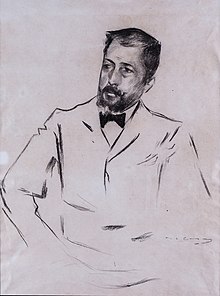Marià Vayreda i Vila

Marià Vayreda i Vila (born October 14, 1853 in Olot , † February 6, 1903 in Barcelona ) was a Catalan painter of realism and writer. He was a member of the Olot School of Painting . He is the brother of the painter Joaquim Vayreda i Vila and the biologist Estanislaus Vayreda i Vila . One of his most famous paintings Viàtic a la muntanya (1887, The priest on the way to the last unction of a dying peasant on the mountain ) is available in the Museu d'Art Modern des MNAC in Barcelona . Marià Vayreda was more interested in the life, the secular and Christian customs of the people in the Garrotxa than in pure landscape painting, as practiced by his older brother Joaquim or his painter colleague Josep Berga i Boix . An art-historical peculiarity lies in the fact that Marià Vayreda created some works together with his brother Joaquim Vayreda. In such works, Marià was responsible for the layout and design of the figures, Joaquim for the design of the landscape. He signed his pictures with “Marian Vayreda”.
life and work
After graduating from high school, Marià Vayreda studied at the "Escuela de Dibuix" (school for artistic drawing) in Olot. After the death of his parents, he joined the Carlist Wehrmacht under General Francesc Savalls in the Third Carlist War . In 1875 he went into exile in Sète in the Languedoc near his brother Joaquim and near his painter colleague Josep Berga i Boix. From 1876 he went to Paris for two years and learned painting in the studio of the painter Jean-Léon Gérôme . Then he returned to Catalonia, specifically to Barcelona. Here he worked from 1877 to 1878 at the "Escola de Belles Arts de Barcelona". Then he went back to Olot for good. As a painter he specialized in depicting human figures, but never had the resounding success that his brother Joaquim was able to record in landscape painting. His best works are those that he created with his brother Joaquim. He founded the company "L'Art Cristià", which manufactured and distributed religious art in industrial production. Gradually he stopped painting and devoted himself to writing. He published articles on cultural topics in "El Olotense", which was renamed "L'Olotí" in 1890, and in "Sang Nova" (1900-1903), which would later become the title of one of his novels. From 1891 he wrote fairy tales. Special mention should be made of his “Records de la darrera carlinada” (1898, memories from the Carlist War ), in which he reproduces his experiences from this war with realism and great accuracy. Important novels are “Sang Nova” (1900, New Blood ) and above all “La Punyalada” (published posthumously in 1904, Die Dolchstecherei ). Here he describes the destruction of an individual within the historical framework of "bandolerism" that followed the Carlist wars in Catalonia. He used a perfect combination of different narrative techniques from Romanticism, Realism, Naturalism, Psychology and Columnism as well as the Catalan mountain dialects.
Literature by Marià Vayreda
- Marià Vayreda: Obres Completes, Pròleg, ordenació i revisió de Josep Mircacle (The complete work, with a preface by Josep Miracle, in Catalan), 1st edition 1984, Barcelona (Editorial Selecta) 1984, ISBN 84-298-0504- 4th
literature
- Enciclopèdia Catalana: Vayreda i Vila, Marià . In: Gran enciclopèdia catalana. 1st edition. tape 15 . Enciclopèdia catalana, Barcelona 1980, ISBN 84-85194-11-X , p. 305 (Catalan).
- Hèlios Rubio et al .: Art de Catalunya (Ars Cataloniae) . L'Escola d'Olot , there also Marià Vayreda i Vila . 1st edition. tape 9 /16 (Pintura moderna i Contemporània). Edicions L'Isard, Barcelona 2001, ISBN 84-89931-19-4 , pp. 200-202 .
Web links
- Literature by and about Marià Vayreda i Vila in the bibliographic database WorldCat
- Marià Vayreda i Vila, in: enciclopedia.cat (Catalan)
| personal data | |
|---|---|
| SURNAME | Vayreda i Vila, Marià |
| ALTERNATIVE NAMES | Vayreda, Marià |
| BRIEF DESCRIPTION | Spanish painter and writer |
| DATE OF BIRTH | October 14, 1853 |
| PLACE OF BIRTH | Olot |
| DATE OF DEATH | February 6, 1903 |
| Place of death | Barcelona |
